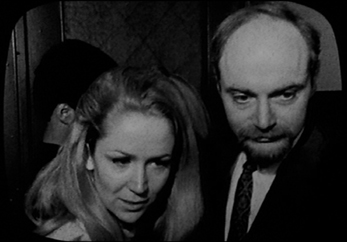
See also:
NightFlight article on Nightdreams
by Bryan Thomas
There weren’t actually too many people working on Nightdreams, though. [Stephen] Sayadian’s partner, Francis Delia — credited as the director of photography (sometimes as director) on the film, using the pseudonym “F.X. Pope” — actually operated the camera. Delia — a native New Yorker — had studied at Cooper Union and worked as as commercial photographer for Madison Avenue Ad agencies, but he was still at the very start of his career, according to his IMDB credits.(As an aside, your humble writer actually met him once and spent an afternoon talking with him at a screening of his 1988 movie Freeway — held in a tiny room at Raleigh Studios as I recall — when he was looking for a music label to release the soundtrack. Sadly, our label passed on that opportunity).
But make no mistake, despite any involvement in Nightdreams by others, even Delia and Stahl, this is clearly a Sayadian film, a vision borne from his unique imagination and talents.
Sayadian has said that maybe five people worked on the crew of the low-budget art/porn film — in addition to Sayadian and Delia, there was a focus puller who made sure the camera stayed in focus, and a construction supervisor who worked on the sets that Sayadian carefully had art directed and he helped build the sets too. Despite the budget limitations, this gorgeous 35mm production is about visually similar — with its German Expressionist-influenced lighting scheme — with the production values of a high-quality, low-budget TV adverts...
...The thriller sequence seems to be patterned on Brian De Palma’s Dressed to Kill (Delia did the key art photography for the movie poster for Dressed To Kill).
Badass Digest's Jacob Knight on Body Double and Nightdreams
Near the beginning of the article, Knight writes about one of the movies De Palma had picked for his "Guilty Pleasures" article in a 1987 issue of Film Comment. "Amongst the apologetics," Knight writes, "was a 1981 slice of smut titled Nightdreams, directed by FX Pope. In reality, FX Pope doesn’t exist. The name was a nom de skin, belonging to commercial photographer and artist Francis Delia who, along with partner Stephen Sayadian, designed ads for everything from Hustler magazine to key art for major motion pictures. Included in their portfolio of immaculately designed one sheets (which also boasts John Carpenter’s The Fog and Escape From New York) was the iconic image for De Palma’s own Dressed to Kill. The admiration wasn’t one sided; in Nightdreams, Delia and Sayadian recreated the image from the piece of art they invented to help sell De Palma’s infamous murder mystery, repurposing it into one of the most harrowing scenes in the history of hardcore."
Film Comment - Guilty Pleasures: Brian De Palma
"There was a very strange movie [Night Dreams (1981, by F. X. Pope)] that was made by the people who made Cafe Flesh. I can’t remember the title, but it’s the one before Cafe Flesh, and is very avant-garde. What makes it so incredible is its surrealism. It was shot very surrealistically and very expensively. The premise is that there’s a woman, Dorothy LeMay, in a kind of psychological observation chamber which is being watched by this psychiatrist. She’s constantly masturbating the whole time she’s being watched. While she’s masturbating, she’s, of course, having all these fantasies. One was when she was a little girl and the jack in the box possessed her. Then she’s a housewife and a black guy, Fast Talkin’ Freddy, in an Aunt Jemima box comes after her—it’s obsessed with boxes."
Updated: Friday, March 3, 2017 4:27 AM CST
Post Comment | Permalink | Share This Post






 I really enjoyed seeing Jordan Peele's uproarious Get Out in a packed theater a couple of weeks ago, and found it to be one of the more creative films I've seen in a while.
I really enjoyed seeing Jordan Peele's uproarious Get Out in a packed theater a couple of weeks ago, and found it to be one of the more creative films I've seen in a while.  Brian De Palma's Blow Out will be the first of five films to be screened and discussed as part of a five-week course titled "Film/Style." The course, currently filled to capacity, will be taught by Diana Martinez at
Brian De Palma's Blow Out will be the first of five films to be screened and discussed as part of a five-week course titled "Film/Style." The course, currently filled to capacity, will be taught by Diana Martinez at 
 This is a couple of months old, but you'll recall (surely) that this past December, The Film Society of Lincoln Center presented a film series titled, "Going Steadi: 40 Years of Steadicam." Brian De Palma's
This is a couple of months old, but you'll recall (surely) that this past December, The Film Society of Lincoln Center presented a film series titled, "Going Steadi: 40 Years of Steadicam." Brian De Palma's 

